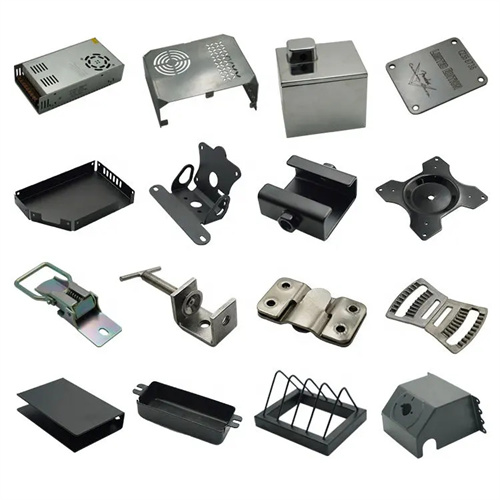Segmented punching scrap design
Segmented waste punching design is a highly efficient technology for handling large or odd-shaped waste. By breaking down continuous long strips or large pieces of waste into smaller segments or chunks, it makes it easier to discharge and collect, reduces the risk of blockage, and improves production efficiency. Segmented waste punching design requires rationally setting the punching position, number of punches, and punching method based on the shape, size, material properties, and stamping process of the waste to ensure that the segmented waste can pass smoothly through the discharge channel without affecting the forming quality of the part.

The location and spacing of the segmented punching sections are crucial and should be determined based on the length and rigidity of the scrap. For long scrap strips exceeding 500mm (such as the offcuts from side-edge punching), multiple punching stations are required to divide the scrap into segments of 300-400mm in length. The spacing between the punching sections must be uniform and smaller than the minimum turning radius of the discharge channel to prevent the segmented scrap from becoming stuck in the channel. The punching locations should avoid the forming area of the part to prevent the punching forces from affecting part precision. For example, in a continuous die, the segmented punching stations should be located in an empty station or scrap area, at least 50mm away from the part forming station. For irregularly shaped scrap (such as flange residue after deep drawing), punching blades should be set according to the scrap’s contour characteristics to segment it into regular geometric shapes (such as rectangles and triangles) for easier discharge and recycling.

The tool structure for segmented punching must meet strength and durability requirements. Common tool types include fixed cutter blades, rotating blades, and movable shear blades. Fixed cutter blades are suitable for materials less than 3mm thick. The blade body is made of hardened Cr12MoV (HRC 58-62), with a cutting edge angle of 30°-45°. It is bolted to the die or stripper plate, and the shear clearance with the lower die is 5%-8% of the material thickness. Rotating blades are suitable for high-speed punching (>500 strokes/min). Driven by a servo motor, the blade speed is synchronized with the punching speed, achieving continuous cutting through circular motion. The blade is made of high-speed steel W18Cr4V, and the cutting edge requires regular grinding to maintain a sharp edge. Movable shear blades are driven by a cam or cylinder, performing the shearing action at specific points in the punching stroke. They are suitable for thicker materials greater than 3mm. The shearing force is provided by a dedicated hydraulic cylinder to ensure a thorough shearing process.

The coordinated control of segmented punching and the main stamping process is an important link to ensure continuous production, and the electrical control system needs to achieve synchronization of actions. The trigger signal for segmented punching usually comes from the crankshaft angle sensor of the press. When the punching reaches the predetermined number of times or position, the control system issues a command to drive the cutting device to operate. For continuous molds, the step distance of the segmented punching station must be consistent with the feeding step distance to ensure that the waste can be accurately cut off each time the punching is performed. For example, for a mold with a feeding step distance of 50mm, a segmented punching is triggered every 6 steps (i.e. 300mm) to control the waste length to about 300mm. In high-speed stamping, a PLC high-speed counting module is required to ensure that the synchronization error between the punching action and the stamping cycle is less than 0.01 seconds to avoid interference between the tool and the punch.

The safety design of segmented punching cannot be ignored, and protective devices and overload protection must be installed to prevent waste from splashing and equipment damage. A protective cover (using transparent plexiglass) must be installed around the cutting knife, and the distance between the protective cover and the tool should not exceed 10mm to prevent waste fragments from flying out and injuring people. The drive mechanism of the tool must be equipped with overload protection. When the shear force exceeds the set value (generally 1.2 times the rated shear force), the system automatically shuts down to avoid tool chipping or motor burning. For rotary blades, a braking device must be installed to stop rotation within 0.5 seconds in an emergency stop to reduce safety risks. In addition, the waste debris generated by segmented punching needs to be cleaned up in time through a chip suction device to avoid accumulation on the mold surface affecting normal operation.

The economic analysis of segmented blanking waste design needs to consider the balance between mold manufacturing cost and waste disposal cost. Although the segmented punching device will increase the complexity and manufacturing cost of the mold (usually by 10%-20%), it can significantly reduce the downtime losses caused by blockage and the labor costs of waste handling. For example, after a certain automobile parts production line adopted segmented punching, the downtime caused by waste material blockage was reduced from 2 hours per day to 15 minutes, saving more than 100,000 yuan in annual production costs. For high-value materials (such as copper and titanium alloy), segmented punching can improve the recycling rate of scrap, reduce material waste, and further improve economic benefits. Therefore, when producing in large quantities or processing large and irregular scrap, the segmented blanking scrap design has significant technical and economic value.
